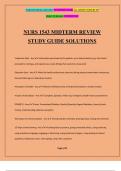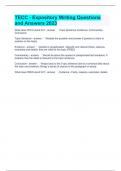©GRACEAMELIA 2024/2025 ACADEMIC YEAR. ALL RIGHTS RESERVED
FIRST PUBLISH OCTOBER 2024
NURS 1543 MIDTERM REVIEW
STUDY GUIDE SOLUTIONS
Subjective Data - Ans:✔✔-Information perceived by the patient, up to determination (e.g. Pain Scale)
perceptions, feelings, and experiences, levels (things that cannot be measured)
Objective Data - Ans:✔✔-What the health professional observes during physical examination (measured,
factual) (Vital signs or laboratory results)
Perception of Health - Ans:✔✔-Patient's definition/view of health (biomedical or holistic model)
4 Types of Data Bases - Ans:✔✔-Complete, Episodic, Follow Up, Emergency health history assessments
OPQRSTU - Ans:✔✔-Onset, Provocative/Palliative, Quality/Quantity, Region/Radiation, Severity Scale,
Timing, Understanding patients perception
Techniques of Communication - Ans:✔✔-Introducing the interview, working phase, closing the interview
10 Traps of Interviewing - Ans:✔✔-Providing false assurance, giving unwanted advice, using authority,
using avoidance language, engaging in distancing, using professional jargon, using leading or biased
questions, talking too much, interrupting, using 'why' questions
Page 1/19
, ©GRACEAMELIA 2024/2025 ACADEMIC YEAR. ALL RIGHTS RESERVED
FIRST PUBLISH OCTOBER 2024
IPPA - Ans:✔✔-Inspection, Palpation, Percussion, Auscultation
Inspection - Ans:✔✔-Visual examination of the body, looking for visual abnormalities (comparisons)
Palpation - Ans:✔✔-Examination technique done by touching the patient, pressing or applying pressure
to feel texture, tenderness, and temperature
Percussion - Ans:✔✔-Tapping on the surface of a patient to determine differences in sound, listening for
abnormalities
Auscultation - Ans:✔✔-Listening with a stethoscope for abnormalities, assessing functions of internal
organs and breathing patterns
Inspection: Common Inspections - Ans:✔✔-Symmetry, Colour, Posture, Patient Gestures
Palpation: How to Palpate - Ans:✔✔-Skin temperature = dorsal/back of hands, Tactile discrimination =
fingertips, Position + Shape of organ/mass = grasping of fingers + thumb, Vibration =
Metacarpophalangeal joints/ulnar surfaces
Percussion: Tympany - Ans:✔✔-Fluid-filled organs producing high-pitched drum-like sounds
Percussion: Dullness - Ans:✔✔-Dense tissue zones producing thud-like sounds
Percussion: Resonance - Ans:✔✔-Sounds from adult lung tissue, low-pitch and hollow, non-clear sounds
could indicate fluid in lungs
Page 2/19
, ©GRACEAMELIA 2024/2025 ACADEMIC YEAR. ALL RIGHTS RESERVED
FIRST PUBLISH OCTOBER 2024
Percussion: Hyperresonance - Ans:✔✔-Sounds from child lung tissue, increased air, lower-pitch, booming
sound
Percussion: Flat percussion - Ans:✔✔-Sounds from muscle, bone, tumor areas, very short duration,
instant stop of sounds
Auscultation: Layers of Skin - Ans:✔✔-Epidermis, Dermis, Hypodermis (Subcutaneous Tissue)
Epidermis - Ans:✔✔-Outermost layer of the skin, protective layer against environment, pathogens, UV
rays
Dermis - Ans:✔✔-Layer under the epidermis, thick layer of connective tissue containing blood vessels,
nerve endings, hair follicles, sweat glands, sebaceous glands, collagen, and elastin fibers
Hypodermis - Ans:✔✔-Deepest layer of the skin, located beneath the dermis, contains adipose (fat)
tissue and connective tissue, functions as an insulator and cushion
Functions of the Skin - Ans:✔✔-Protection, Prevention of Penetration, Perception, Temperature
Regulation, Identification, Communication, Wound Repair, Absorption + Excretion, Production of Vitamin
D
Skin Development for Newborns - Ans:✔✔-Lanugo, Vernix Caseosa, increased risk for fluid loss,
ineffective temperature regulation
Page 3/19





